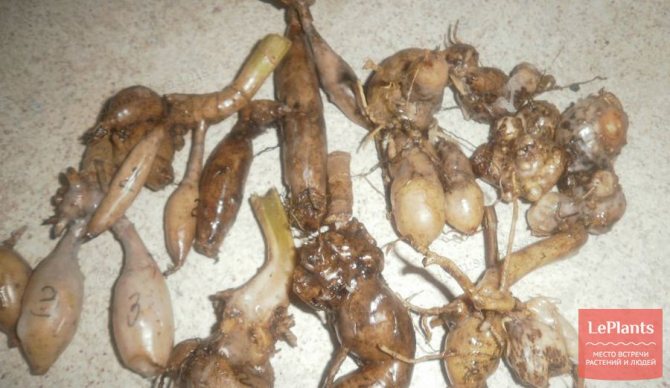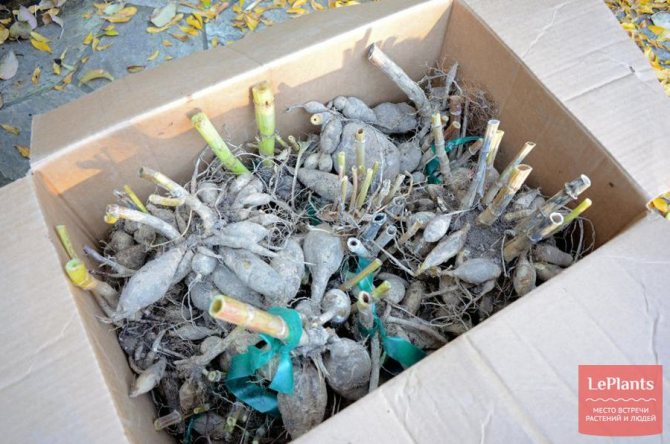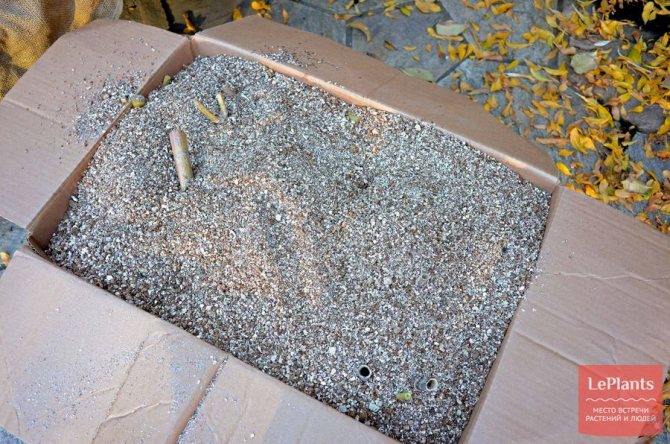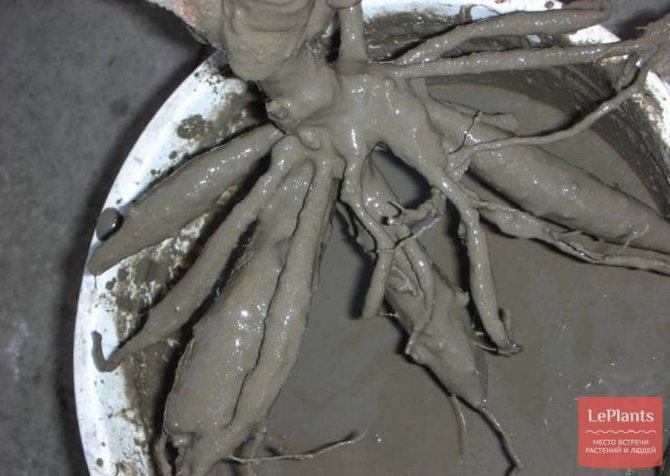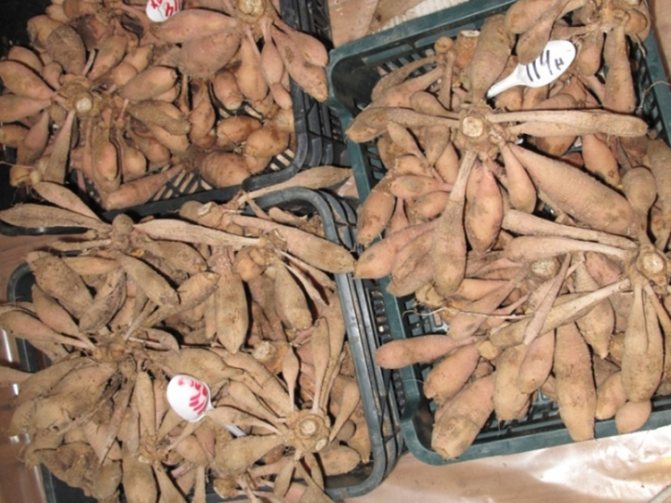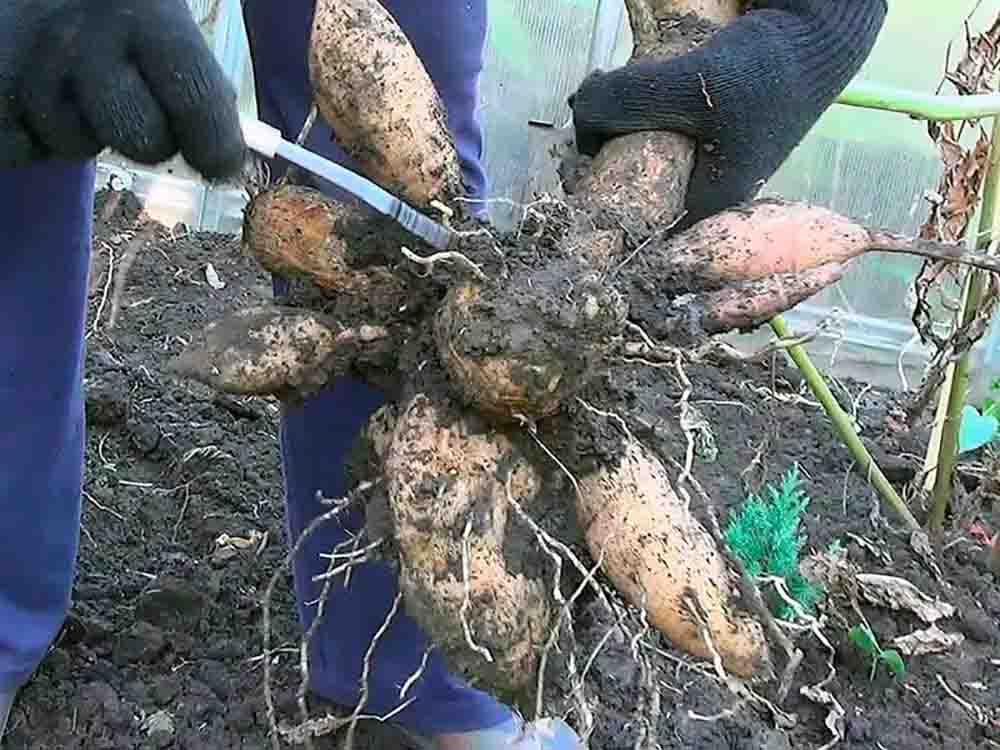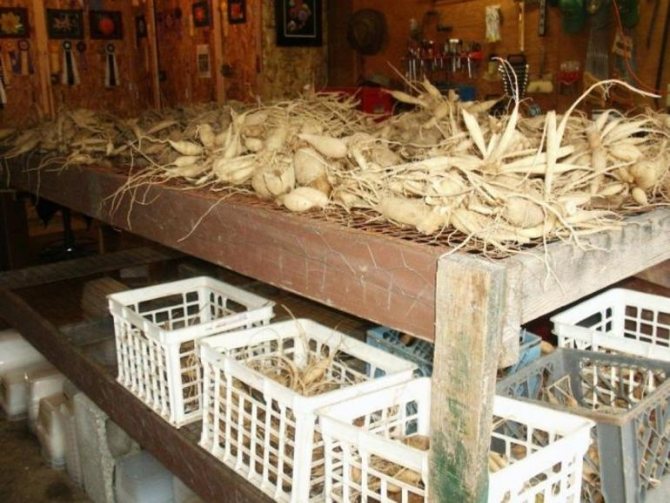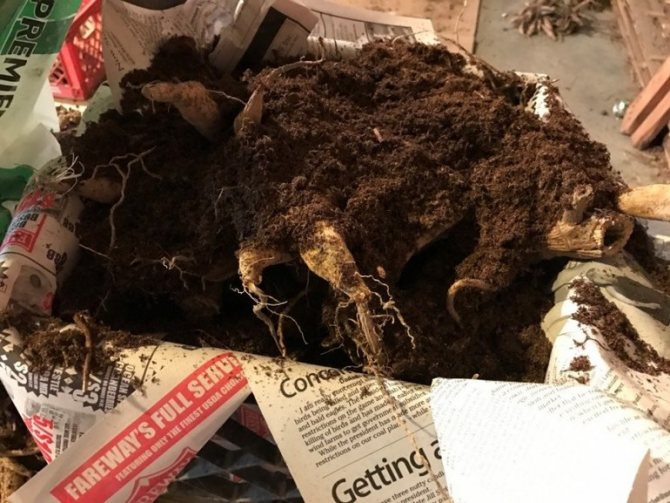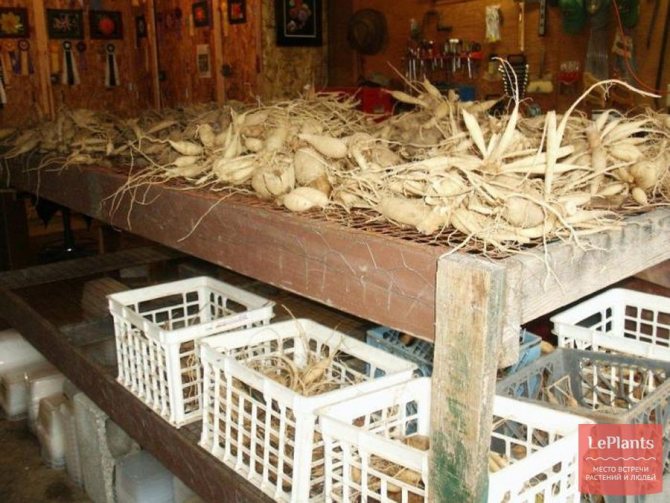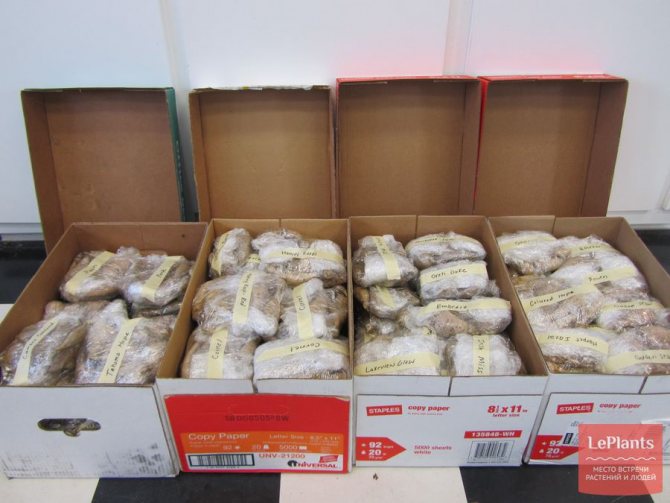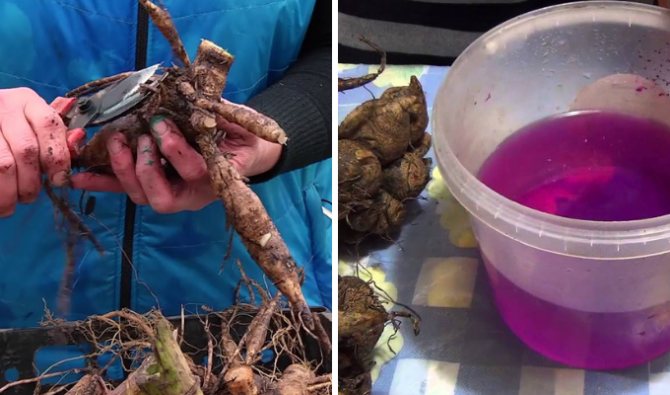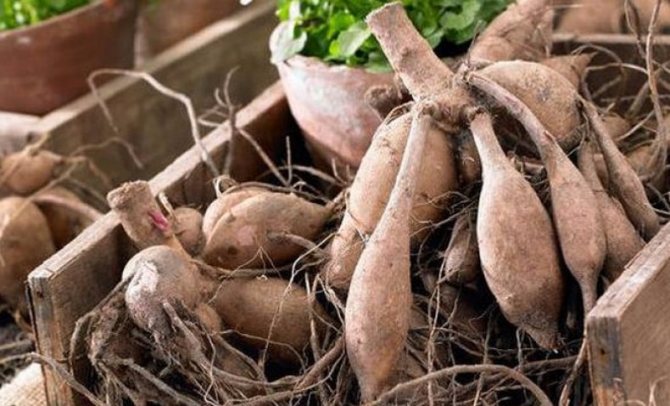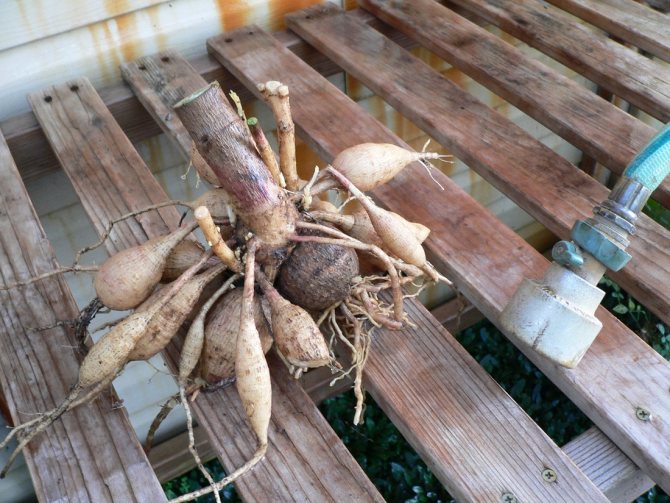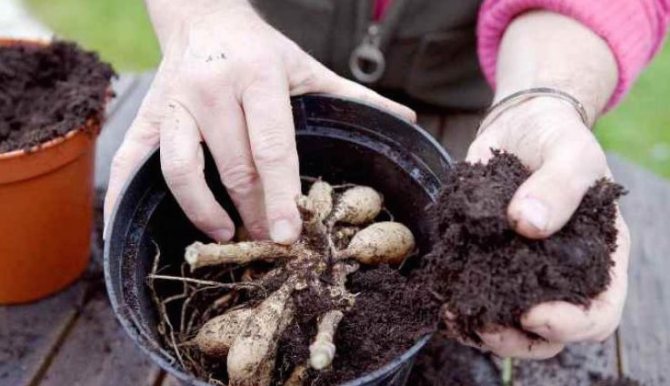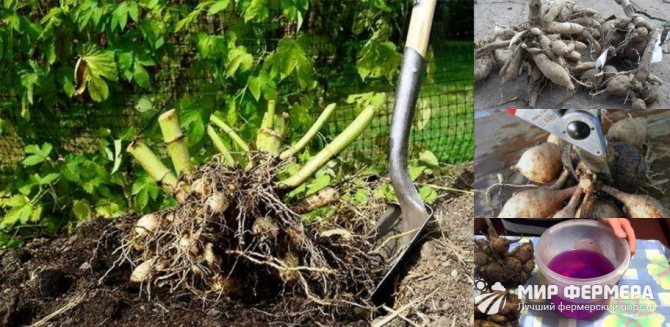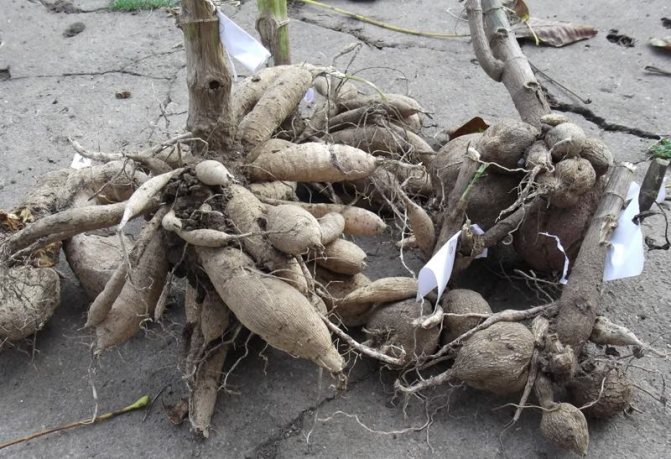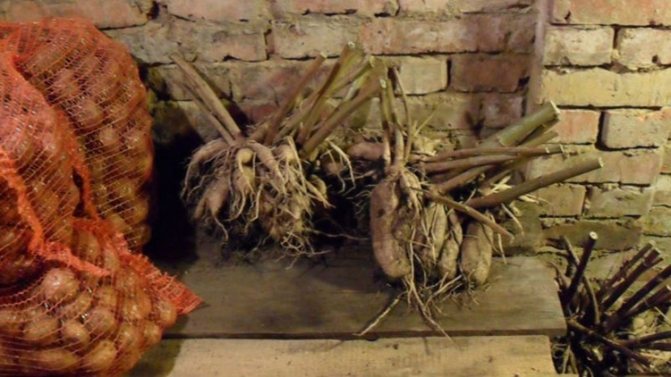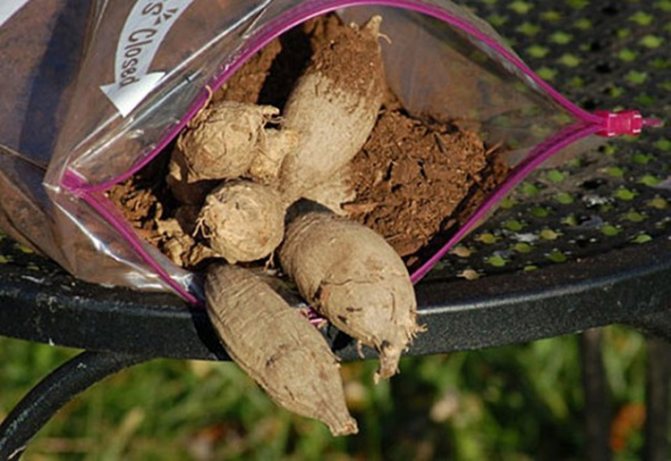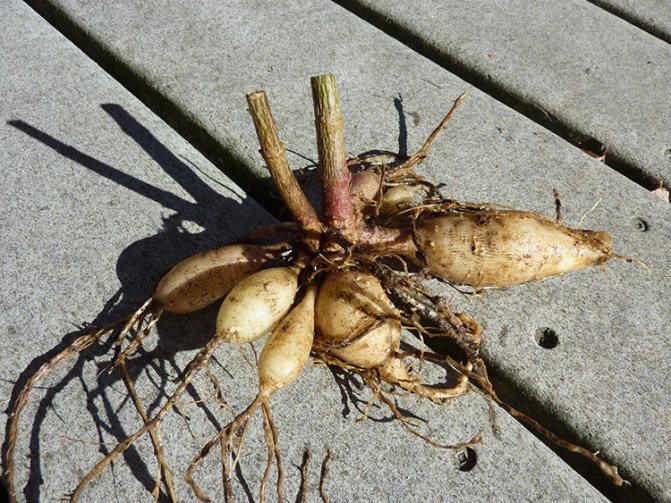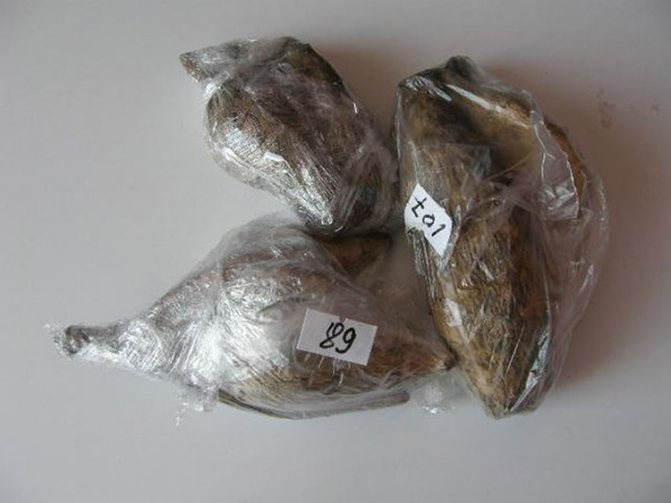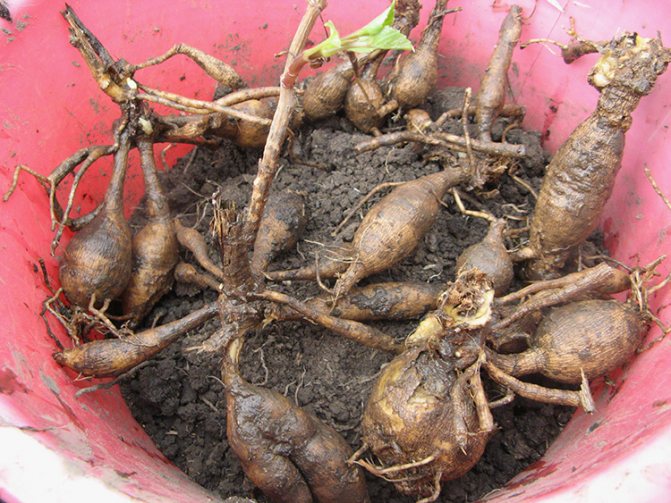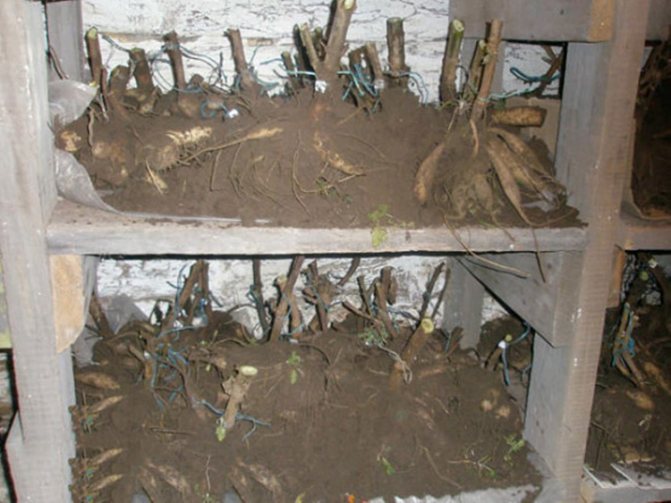Sometimes even experienced flower growers are faced with the problem of preserving dahlias in the winter. And many beginners who have managed to become attached to these beautiful flowers do not know at all how to store dahlias.
At the dacha, nothing pleases as a bountiful harvest and a luxurious flower bed. When you can sit down to relax surrounded by colorful dahlias, which delight with their brightness and beauty. However, by the arrival of autumn, it is necessary to start preparing for the first frost and do everything possible to preserve the delicate tubers of your favorite plants. Therefore, many beginners ask several questions at once:
- When is it time to dig up a dahlia?
- How to properly dig up tubers so as not to damage them?
- What are the nuances when preparing dahlias for winter?
- What are the ways to store at home?
The answers can be found today, you should pay enough attention to the recommendations of experienced florists. After all, why experiment if there are already effective methods that have been developed over the years.
How and when to dig up dahlias for storage
You should not rush to dig up root tubers. The longer they are in the soil, the more successful storage will be.
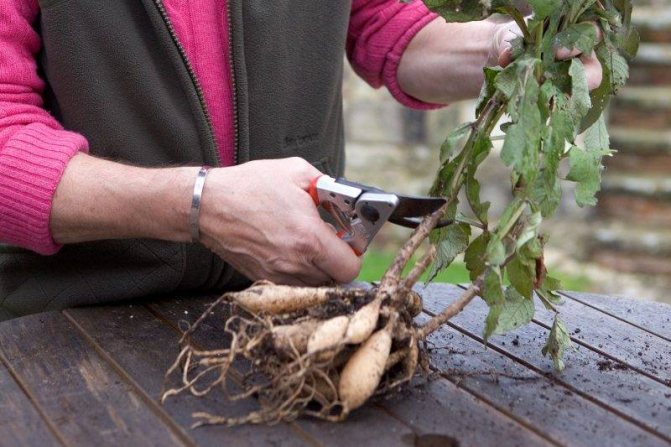
It is important not to miss the time to dig up the dahlias, otherwise frost can damage the tubers of the plant.
- If the gardener has a large collection of dahlias, then the harvesting of root tubers begins right before frost or a period of prolonged rains.
- If only single specimens grow in the garden, they are dug up after the onset of light frosts.
A slight frost damages only the inflorescences and leaves, while the tubers in the soil are still ripening.
Before they are harvested, the plants are cleaned: they dig up and throw away all the rotten and sick specimens, otherwise they will infect the rest.
Digging order:
- Cut the stems of the flowers, and carefully remove the tubers, being careful not to injure the neck. To do this, it is better to carefully dig them up on four sides and only then push them out of the soil. Of course, when using this technique, long roots are damaged, but the root tubers themselves remain intact.
- Remove the soil, and turn the root tubers and leave for 2 - 3 hours to dry.
- Autumn is the best time to breed dahlias. To do this, they need to be washed and carefully divided into parts.
- To protect the cuttings from rotting and various diseases, it is recommended to treat them with fungicides before storing them, soaking them in a prepared solution for ¼ h. ... For safety reasons, all work with chemicals is carried out only with gloves.
After processing, all the delenki are dried, but not on concrete, since it strongly absorbs moisture, which is why the root tubers begin to wrinkle prematurely.
Dahlia digging dates
The timing of digging dahlias depends on several factors. Namely:
- the degree of maturity of their tubers;
- ambient temperature;
- the timing of the onset of the rainy seasons.
So, dahlias should be dug when the tubers have accumulated a sufficient amount of nutrients and are fully ripe. But at the same time, one cannot wait until the arrival of heavy autumn rains, and even more so, one cannot wait for stable frosts.Therefore, experienced gardeners recommend:
- With mass breeding of dahlias, it is better to dig out their tubers before the first night frost in the dry period, before it rains.
- If only a few specimens grow in your garden, then you can dig them out immediately after the frost freezes the above-ground part of the plant, and it turns dark in places. At the same time, the stems and leaves will begin to rot, but the roots that are underground will remain intact. Rot will not spread on them if you separate them from the shoots in time.
For the south of Russia, these dates usually fall on the beginning or mid-November, and in mid-latitudes, including the Moscow region, in mid-October. In the Urals, dahlias need to be dug up for storage in early October, and in Siberia - in mid or late September.
Optimal storage conditions for tubers
Ripe root tubers from strong and healthy plants do not require special conditions for wintering. But there are rare varieties that painfully endure this period, and they need to provide the most optimal conditions for storage.
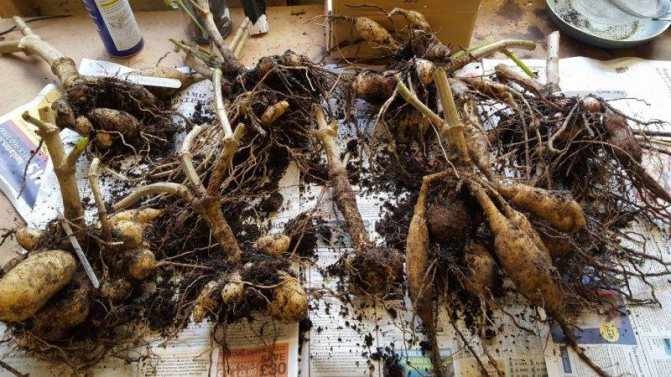

Storing dahlias requires a certain temperature and humidity.
- The temperature should vary between 2 and 7 ° C. At low temperatures, the planting material can freeze, and at high temperatures, it can rot or germinate prematurely.
- The optimum moisture content is 80 - 90%. If this figure is lower, the root tubers will shrink and will not be able to germinate.
Storage features largely depend on the level of humidity in a particular region. In areas with wet winters, planting material should not be stored in hermetically sealed bags. It is imperative to pierce 5 - 6 holes for gas exchange.
How to use a refrigerator for storage
If it is not possible to send dahlia tubers to the cellar, and the apartment is very warm, then you can find another way out. Small volumes of planting material are stored in the refrigerator. To do this, you need to stock up on packages and large sawdust. Prepared tubers are placed in makeshift containers so that they do not come into contact with each other. It is required to lay the material at a distance, and sprinkle each layer with sawdust. It is necessary to make holes in the bag, which will allow to create air access in the required amount and ventilation.
Whichever storage method is chosen, the planting material must be checked monthly. If the tubers show signs of rotting, mold or other diseases, then they must be separated from healthy ones. The damaged area is cut off, processed again with clay or ash. For more safety, it is better to put a separate container for such roots. In the spring, boxes, containers and bags with dahlias are moved to a warm room. This contributes to the rapid awakening, and subsequently amicable sprouting of shoots.
With the correct collection of planting material, optimal temperature and humidity during storage, the tubers are well preserved and do not deteriorate. Nevertheless, they must be checked and, if necessary, the conditions of the maturation must be adjusted. If everything is done correctly, then bright lush dahlias will decorate the flower beds by the middle of summer.
Storing dahlias in the apartment in winter
Since it is difficult to find a cold place in urban apartments during the heating season, it is better to store dahlias in hermetically sealed PET bags mixed with very dry perlite.
The most suitable place in an apartment for storing dahlias is a balcony. However, the tubers should be protected from frost.
If the rooms are humid and warm, only waxing will do. But such processing has not become widespread, since it is rather laborious. In addition, paraffin-treated delenki wake up much later. But in some cases, there is no other way out. Such root tubers are stored in bags with coniferous sawdust or dry peat.
The balcony is a good storage space. Root tubers are washed, dried, wrapped in thick paper and a bag, leaving it ajar for airing. If it's freezing outside, it is recommended to take the planting material into the room, and then take it back to the cool balcony.
Dahlia waxing
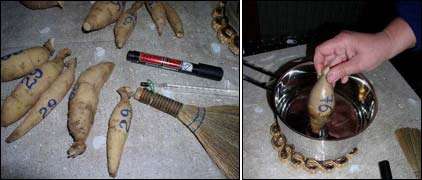

Waxing dahlia tubers prevents moisture evaporation. Before waxing, we bring the corked roots into a room with a temperature of 15 degrees for one day. Further, the warmed dahlia tuber must be divided into parts (divisions) with buds, as shown in the photo.
Dahlia buds are located on the kidney ring; depending on the variety, this can be at the base of the stem or slightly higher. At elevated temperatures, the kidneys swell and become visible.
We divide the dahlia tuber according to the principle: one bud - one division. Try to divide the tuber into four parts for the first time, and then learn - the skill will come with experience.
Dry all slices. Sign each division with a marker (put the variety number according to your catalog).
For waxing dahlias, buy wax from a pharmacy or a candle factory (you can use paraffin candles). Melt the paraffin wax to a liquid state in a long-handled saucepan. Very convenient for working with paraffin is a cooker or a milk cooker (a saucepan with double walls, in which the paraffin will not overheat). It is absolutely impossible to do this on a gas stove, since paraffin is highly flammable. You can only work on an electric hotplate with a closed spiral.
Heat the paraffin to a temperature of 70-80 degrees and lower the dahlia cut into it halfway. Then turn the cut over and dip the other half in paraffin.
How to store dahlia tubers in your basement
The best place to store it is in a cool but damp cellar. If the room is dry, you need to take care of sufficient moisture in time. It is very difficult to keep the planting material in its original volume in a warm and damp basement, since such conditions provoke the appearance of various diseases.
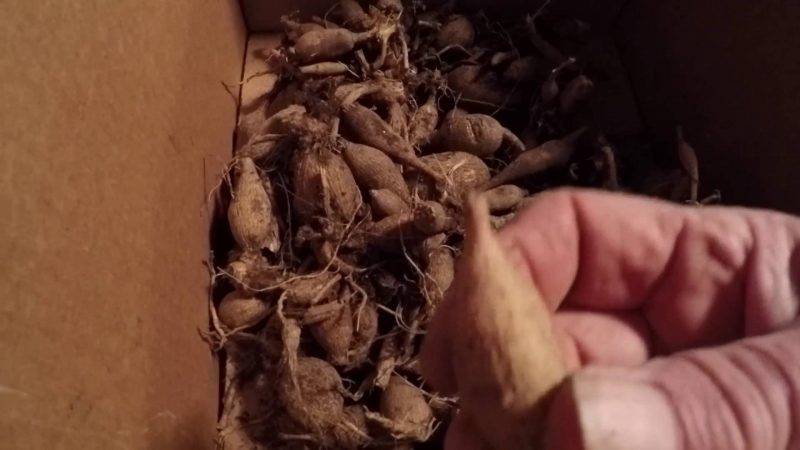

The cellar is the perfect place to store dahlias in winter.
- It is convenient to store dahlias in the basement in tight plastic bags filled with large vermiculite. The main condition is a low storage temperature (maximum 7 ° C). The fact is that this material retains moisture and, when the temperature rises, can lead to rotting of the tubers.
- A good option is to use sand. Dahlias are stored well in it, but in spring they can give premature young shoots.
- Large softwood sawdust is also used for storage. Small sawdust is not suitable as it will draw too much moisture from the root tubers.
- Also, planting material is stored directly in the ground. To do this, take large wooden boxes, cover them with several layers of paper so that its edges not only cover the bottom, but also the sides. A thin layer of soil is poured at the bottom, the tubers are laid out at a sufficient distance from each other and again covered with soil, filling all the voids. This is done until the entire box is full. From above it is also covered with paper.
To prevent the root tubers from drying out, they are covered with a clay shell.
After digging, the delenki are kept in a solution of potassium permanganate for 12 hours, then dipped in a mash made of clay, water and any fungicide. Root tubers treated in this way are dried and removed to a cold dry cellar. With the onset of heat, the clay shell is broken by tapping and dahlias are immediately planted.
How to prepare tubers before winter storage
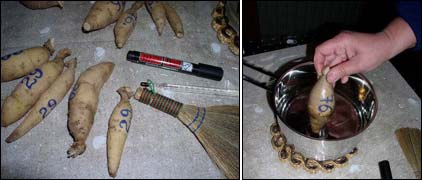

Regardless of how you are going to store dahlias in winter, plant tubers must be properly prepared. Preparation consists of four mandatory stages:
- Washing... Rinse the newly dug tubers in a bowl with lukewarm water to remove dirt particles from them. During flushing, you need to cut off all the processes with a well-sharpened knife or scissors.
- Division... Before sending the rhizomes for storage, they must be separated from each other. To do this, you first need to cut off the stems from the top of the tubers. Then divide them so that there are several developed buds on each tuber. If the buds are weak and the rhizomes are very hard, then it is better not to separate them.
- Disinfection. To preserve dahlias until spring, you need to minimize the risk of fungal infection of the tubers during storage. To do this, they need to be disinfected in a special solution. For these purposes, you can use both potassium permanganate and preparations from the group of fungicides. If you chose the first option, then dilute 1 g of potassium permanganate in 10 liters of water and soak the tubers in the solution for 20-30 minutes. An alternative option is a 0.2% Fundazole solution (fungicidal agent). You can soak the rhizomes in it for up to 2-3 hours, but not less than 30 minutes.
- Drying. Only dry tubers can be stored. If they remain wet, they will rot, and no amount of disinfection will prevent this: it will only delay the inevitable. Therefore, after disinfection, leave the rhizomes in a dry and well-ventilated area. It should be cool and dark.
After complete drying, which can take 1.5-2 weeks, the tubers can be stored in a prepared room.
When and how to properly dig up dahlias for storage
In many forums about gardening, novice summer residents often ask various questions about the rules for storing dahlia tubers. Here is one quote: "I bought dahlias in February, how to store them?" To get flowering bushes as early as possible, plants begin to deal with plants early - in February-March. And it is customary to dig up and store tubers in regions with rather harsh and unpredictable winters.
It is recommended to start digging root crops with the arrival of the first autumn frosts, when the leaves turn black from frost.
It is important not to delay with this procedure, otherwise low temperatures can destroy leaves and shoots. As a result, rotten shoots will spread to the root system.
Digging too early is also contraindicated: you risk getting fewer flowers next season, and the tubers will be worse stored. While the leaves are still green, the natural process of feeding the roots is going on, and the buds are preparing for the next flowering. Before digging up and storing dahlias for the winter, you need to cut the stems. Pruning helps to avoid accidental damage to the buds or roots.
To avoid damaging the root collar, leave hemp above the ground about 20 cm - that's quite enough. In order not to rip off the neck of the flower and render it unusable, do not place the shovel too close to the stems, and also do not try to pull the bush by the stems. To safely remove the tubers from the ground, dig in the bush with a shovel from all sides at a distance of about 30 cm, rake off the soil and carefully remove the tubers.
Further high-quality preparation of the roots for storage is considered the key to success. There are many options for how to store dahlia tubers at home, but whichever method you choose, there are a number of mandatory preparatory operations:
- Flushing. Shake the dug out bush from the ground. Then rinse the tubers from the residual soil with plenty of water.
- Shortening. The excess shoots from the tubers must be cut off with sharp scissors. The tubers are shortened by about 15 cm.
- Division. We start dividing the rhizomes. Cut the stems almost to the base of the root tubers. Each root cut should have a kidney. If the roots are very hard, and the buds on them are underdeveloped, you can leave them whole.
- Disinfection. By immersing the tubers in a potassium permanganate solution for 30 minutes, you will prevent rotting and the possible development of fungal diseases. The roots can also be treated with a fungicide. Check each piece for damage and signs of illness. Any dark or rusty spots must be removed. White bloom can often be found on tubers - this is the initial phase of fungal infection. If nothing is done, then such a root will become the cause of infection of all planting material, you will not be able to save the harvest until spring.
- Drying. After washing, be sure to let the tubers dry in the fresh air. And before storing dahlias after digging, it is advisable to leave the tubers for 10 days in a cool room. This is done in order to heal shallow root wounds.
Features of the root system of dahlias
Dahlias have a rather complex root system. It consists of thickened roots, called storage tubers, and slender roots, which supply nutrients to these very tubers. During the period of plant growth, tubers increase in volume, accumulating the necessary nutrients, and retain their viability during the winter storage period. Each thickened tuber can live for 3-4 years. At the same time, less saturated tubers and thin roots die during the winter storage period.
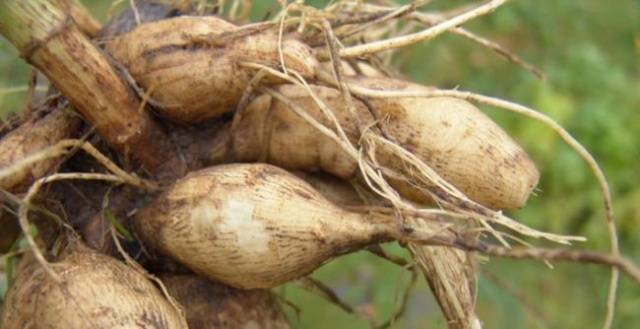

The roots of heat-loving dahlias are dug up for the winter and stored in favorable conditions until spring. However, it is necessary to understand that the bud of the growth of new shoots of the next season is not on the roots themselves, but in the lower part of the shoots of the last year, therefore, when cutting the bush in the fall, it is necessary to leave a small shoot of the stems.
How to store dahlias in winter, storage at home
How and where to store dahlias in winter is a particularly relevant issue for urban gardeners. That is why we decided to collect the most relevant options for storing root tubers, which allow you to do this even in an apartment.
Storage in boxes
Not everyone has the ability to store tubers in a basement or in a special storage. Therefore, for keeping in a city apartment, the roots are usually placed in boxes, which are then transferred to the coldest place (for example, next to a balcony door or in a vestibule).
Keeping in boxes is one of the most acceptable ways how to keep dahlias at home. The roots are neatly placed in a box on a layer of peat, and they are also covered with peat on top. Peat can be replaced with sand or sawdust (preferably conifers).
Sand storage
Next, let's look at how to store dahlias in the sand in winter. A container with a volume of about 20 liters is filled with well-dried sand. Dahlia roots in 1-2 layers are immersed in a box, covered with burlap.
According to numerous reviews, the tubers are excellently preserved. This method is also convenient in that it allows you to check the condition of the roots in winter. However, this method also has disadvantages - a lot of sand is required... In addition, the flowers themselves begin to sprout and suck roots much earlier than the required time.
The main danger when storing root tubers is excessive moisture. Moistening the used sand is a common mistake when storing dahlia roots in sand. It may seem that the sand is completely dry, and the roots are drying up. However, from moisture, the roots either rot or germinate ahead of time. It is better to dry them out, since overdried roots can still be restored, but rotten ones are no longer there.
Storage in paraffin
Waxing or dipping tubers in molten paraffin is laborious, but one of the favorite methods of skilled gardeners. Root tubers treated with paraffin are much better stored. Paraffin does not allow moisture to disappear, the roots do not dry out.
In addition, in the process of processing with paraffin from exposure to high temperatures, all pathogens that were on the roots die.
After hardening, the paraffin forms a protective layer, due to which the negative impact of external factors is absolutely not terrible for the dealers. When choosing a waxing method for storage, it is important to remember that the delenki in this case wake up much later. This method is only suitable for early plant varieties. So, let's analyze how to keep dahlia tubers in paraffin. Dahlia tubers are waxed as follows:
- Paraffin or candles are ground, put in a pot of water. Next, this pan is transferred to a larger container and placed in a water bath.
- Paraffin is melted over low heat. The thickness of the melted material should be 2-3 cm.
- In order for the root tubers to fit into the pan, they may have to be divided. The washed and dried roots are tied by a thread, dipped in hot paraffin and immediately taken out. In air, paraffin hardens immediately.
Storage in vermiculite
Next, we will discuss how to keep dahlia tubers in vermiculite until spring. Vermiculite perfectly retains moisture, which means that you don't have to worry about drying out the tubers. On the other hand, it is this factor that can cause early germination of tubers even with a slight increase in temperature at the place of keeping. It is recommended to choose not ordinary garden vermiculite, but coarse-grained.
The bottom of the container chosen for storing root tubers is covered with vermiculite, then a layer of roots is laid. Thus, one by one, the entire container is filled. Then the workpiece must be covered with plastic wrap and transferred to a cool room (3-6 ° C).
Storage in sawdust
Storing dahlias after digging in sawdust is a fairly simple, affordable and reliable option. The only condition for the successful storage of tubers is large sawdust, even better shavings. Choosing small sawdust, there is a risk that they will draw out all the moisture. Sometimes the roots with sawdust are canned in bags. This is an unacceptable mistake, since the roots of the flower in polyethylene rot due to the condensation formed. Root tubers die from high humidity.
Stages of preparing tubers for storage


The question of whether it is necessary to dig dahlias for the winter should not even arise - the pineal tubers will simply freeze over in the cold ground. In addition, there are vegetative buds on the root collar, with the help of which the bush actually develops. Already from February they begin to swell in order to give new shoots in May (which is unrealistic in winter soil conditions).
Tubers are not just dug out of the ground - they still need to be properly prepared for storage. The whole procedure can be broken down into step-by-step actions:
- Digging up root tubers;
- Treatment;
- Drying of rhizomes;
- Division for subsequent reproduction.
First of all, you need to take care of the room in which the tubers will be stored. It should be moderately cool and humid, which is quite consistent with the conditions of the cellar. If you do not have the opportunity to store dahlias at your dacha, summer residents will have to move the tubers to the apartment, creating a suitable atmosphere for them there. Based on the storage conditions, options for processing rhizomes are selected.
Storage methods for tubers:
- In a clay "casing";
- In wet sand;
- In lime;
- In paraffin;
- In cling film;
- In vermiculite.
Interesting! Some growers have adapted their refrigerator for storing dahlia rhizomes. This allows you to systematically check the condition of the planting material.
Prerequisites for storing dahlias at home
Dahlias for storage must be taken from beautiful and large bushes, since the forecast for the preservation of the tubers of such plants in winter is the most favorable. The roots of weakened and thin plants do not take root.
In different years, different varieties of dahlias are stored differently. Much depends on the weather during the growing season and on the place of planting (in the sun or in partial shade).Dahlias evolved from the crossing of thermophilic plant species, and Guatemala, Peru, Chile and Mexico are considered their homeland. Therefore, these flowers are not winter hardy.
In addition, wild dahlias grow in short day and cool night conditions. This explains the late flowering of these plants in our climatic zones. However, Fubuki Kogan and Mingus Tony are very reliable varieties.
Choosing for yourself the most suitable way of how to store dahlias at home, it is important to remember the necessary conditions. Based on the foregoing, these include: low temperature (3-5 ° C), sufficient air humidity (approximately 60-70%) and good ventilation (to avoid root rot).
Cornelubni are perfectly stored in the cellar, in a cool garage or annex. At the same time, periodically they still need to be taken out into the street for ventilation.
If you live in an apartment, the storage principle remains the same, but the storage method needs to be thought out more carefully, based on the living conditions. The best option is storage in boxes.
By following all the recommendations and adhering to the generally accepted norms of how to store dahlias in the winter in the cellar, you can enjoy and admire the beauty of these flowers for more than one season. Any of the above storage methods guarantees 90-95% of a successful result.
It is impossible to imagine a modern flower garden without huge terry dahlia hats that adorn it from mid-summer until the very frost. Breeders have bred a wide variety of species and varieties that differ both in the color of the buds and in the shape of the petals.
Dahlias are perennial plants, but in order for them to bloom violently and next year, it is required to dig up their tubers with the onset of cold weather in order to save the plants from freezing. After all, as soon as the first frosts hit, the bushes of these luxurious flowers are a sad sight, and this is only the ground part.
The same thing happens with root tubers - they simply freeze out and die. To prevent this from happening to your pets, you need to know how to store dahlias at home in winter.
How to prepare dahlia tubers for wintering?
First you need to decide when to dig up the tubers, because their storage during the winter period depends on this. There is an opinion that the tubers should be dug as soon as the temperature drops to 0 ° C, but not lower.
You should choose a warm sunny day, because in the cold, the nodules can freeze and deteriorate even before storage. Since the planting material is very fragile, all actions must be done as carefully and slowly as possible so as not to damage the plants.
In the ground, dahlia tubers occupy a fairly large area, about 50 cm in diameter, which means that in order to dig them you will need to retreat about 40 cm from the trunk of the plant and dig a hole deep enough to remove the entire earthen lump. At the plant, you need to leave a root collar about 15 cm long, trying not to break off or damage it.
After the tubers have been dug up, they are washed in large amounts of water to free them from the soil, and then immersed in a slightly boring manganese solution for 30 minutes for disinfection.
Then the tubers are dried in the sun and separated with a shovel or a clean sharp knife, while cutting off the small roots. For storage, you should choose the largest "potatoes", as they produce the highest quality flowers.
At what temperature should dahlias be stored in winter?
Plants will feel best when the ambient temperature is between 5 ° C and 12 ° C. After all, if it is less, then this can lead to the death of tubers. A higher one contributes to untimely germination, depriving the plant of a dormant period.
Where to store dahlia tubers in winter?
To store this planting material, you will need enough space, because there will be a lot of them.Although most often flower growers prefer to leave only a couple of nodules of each variety, and give the rest to neighbors or dispose of, because such a plant as a dahlia is quite prolific and by autumn it grows in a large bush.
Most often, plants are stored in the basement or on the balcony of the apartment. And that and that method is appropriate if the tubers are properly prepared and the air temperature is optimal for this.
There are many options for storing tubers in winter. For this, river sand, peat, sawdust are used, or tubers are simply stored in plastic boxes that allow the plants to ventilate and not rot, as happens in various bulk materials adapted for storage. It is very important that the humidity of the room is not higher than 60%, otherwise the plants will not survive until spring and will rot.
How to store dahlias in the refrigerator?
Usually, the vegetable compartment of the refrigerator has just the optimum temperature and humidity for storing tubers. To protect them from drying and spoilage, each nodule is wrapped in cling film and numbered for convenience so as not to confuse varieties. This method is suitable for those who have free space in their refrigerator.
How to prepare planting material
Dahlia tubers should be in the ground for as long as possible. This will allow you to keep the planting material longer. If you have an impressive collection of plants, harvesting must begin before the rainy or frost season, depending on the climate. The first light frosts can damage the inflorescences and stems, but they will not affect the dahlia tubers in the ground. In this regard, single specimens can be dug up later.
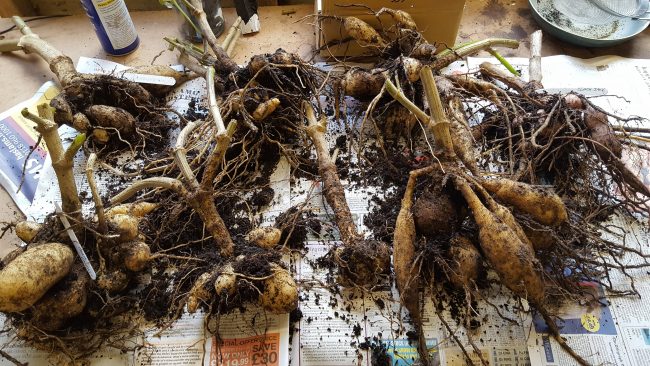

So that storing tubers does not cause problems, it is necessary to dig up the entire plant and remove the damaged areas along with the stems and flowers. The presence of diseased roots can harm others.
Digging Memo
- In order not to damage the root tubers, they must be dug in from all sides and carefully pulled. The shoots must first be cut off slightly above the neck.
- The remnants of the earth must be shaken off, but not knocking against each other, so as not to damage the integrity.
- Root crops have many branches. In autumn, they can be separated for further reproduction. Before dividing the tubers, wash well.
- To prevent the separated roots from disappearing during long-term storage, they must be placed in a fungicide solution for 15 minutes. The floating parts are thrown away, as they will not take root.
Before placing the delenka in the cellar, it must be well dried. It is not recommended to spread the roots on concrete, it dries and dehydrates the planting material very much.
Waxing
- We take the cheapest candles, a large pot, put it on the stove.
- We throw ONE candle, stir a little.
- Your candle will dissolve, but the water should not boil yet.
- We set aside the pan, wait a little.
- And now the waxing process itself: we take the tubers by the left trunks, with a quick movement we lower them into the pan and immediately take them out. The entire tuber is covered with a thin layer of paraffin. One candle is enough for 6 medium sized tubers.
- We cut off the bush at a height of 15 cm from the ground.
- We attach a tag with the name of the variety.
- Use a shovel to scrape off the top layer of earth around the stem.
- Dig out the entire tuber with a shovel or pitchfork.
- Shake off the ground, rinse with a stream of water, cut off the entire "beard".
- We put it to dry where they will not be afraid of frost (in a country house, in a garage, but NOT on the street !!!). They feel hot in the apartment. Dry for 1-3 weeks.
- We rewrite the name of the variety with a marker on the tuber itself.
- PARAFFIN if desired.
- We cut off the trunk, leaving 0.5 cm.
- We put them for storage in boxes in the cellar DOWN with the trunks !!!!!
- We fall asleep with DRY sand.
Planting dahlia in spring
Before planting, dahlias must be germinated. To do this, at the beginning of March, they are taken out of the basement or other storage places and are engaged in sprouting tubers. To do this, they are laid out in boxes in one row and the sand is slightly moistened.After 10 days, the first shoots appear. When they reach 5-10 cm, they are planted in separate pots, leaving two sprouts on one tuber. If you leave a lot of sprouts, then there will be a lot of overgrowth, which may not even bloom and, as a result, in the fall, will not give ripe tubers to preserve the variety.
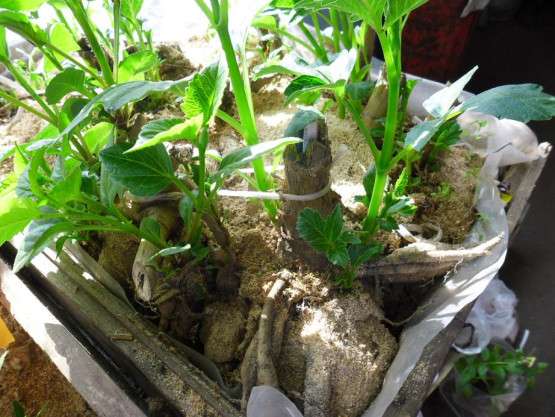

- The tubers planted in pots are further grown, like seedlings, turning from time to time to the sun so that the bushes grow evenly. Planting dahlias in open ground begins when the spring frost has completely passed the region.
- If the tubers are in no hurry to sprout and wake up poorly, they can be planted in the ground in May with their eyes pecked out, sprinkling these small sprouts with earth. Such a planting of dahlias is not afraid of frosts, since by the time they germinate on the surface of the earth, frosts have already passed.
Perennial dahlias are not such difficult flowers to grow, the main thing is to follow some rules when planting and caring for them. And if the tubers are properly preserved in winter, then all summer and until the very frosts you can admire these beautiful flowers.
Dahlia care in autumn - preparing for winter
Now let's figure out how to prepare dahlias for winter. In early September, the bushes need to be quite high spud (about a height of 8-12 cm). This will make them more resistant to wind and cover the base of the trunk, which means the tubers will grow strong. In general, the procedure can be carried out at the end of the summer.
Watering dahlias should be done in moderation so that excess moisture does not lead to infection. Weak stems without buds, lower leaves, as well as dying flowers must be cut off in order to accelerate the formation of new buds.
Preparing dahlias for winter - what to do with them before storing
After the first frost hits, dahlias begin to prepare for wintering. First of all, they carefully examine the bushes and discard plants with obvious signs of disease. Do not feel sorry for them and try to give them a chance, because during storage, infection of healthy tubers may occur, and all flowers will die. After culling, they begin to harvest the soil around the bushes.
Plants that show clear signs of any disease are immediately burned to prevent the spread of the outbreak. Weak dahlias are removed and sent to a compost pit for decay. It is noteworthy that a certain amount of moisture is collected in the tubers in order to be able to withstand drought. During storage, excess moisture can provoke decay processes, so you need to stop watering the flowers a week before the intended harvest.


Frozen dahlia tops should be trimmed
If the frost came unexpectedly and the dahlias did not have time to prepare for the winter period, then you should not rush to remove them. The tubers are left in the ground for as long as time permits. Frozen tops are cut off, leaving 15 cm above the ground surface. In this state, you can keep the bushes for up to 20 days on the site, which will give them the opportunity to mature.
Dahlias cannot hibernate in the open field; in the fall they must be dug up and stored indoors. To do this, carefully dig the soil around the bush with a shovel, take out the tubers and shake them off the rest of the soil. It is necessary to work extremely carefully, trying not to injure fragile roots. Finally, they are laid out in the open air and allowed to dry well.
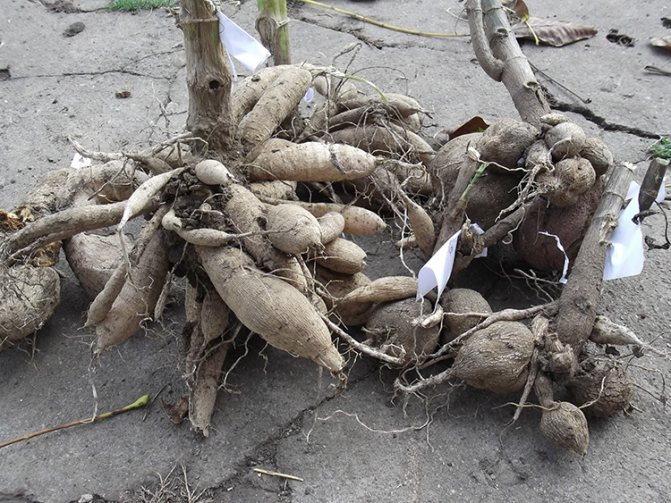

After digging, the tubers must be thoroughly dried.
After the excavated material dries out, they examine it in order to identify damage or the presence of diseases. They also get rid of old tubers, which in the next season will no longer be able to bud. In addition, old rhizomes are very poorly preserved until spring, so it is impractical to send them for the winter.They are easily distinguished by their dark color, pronounced tuberosity and very large size compared to young ones.
There are two conflicting opinions about whether to wash tubers before hibernating. Some growers are supporters of the theory that washing significantly reduces shelf life and destroys cambium. Others are inclined to believe that damage and disease are better visible on clean roots.
When to dig up dahlias?
In the middle lane and the Moscow region, dahlias are dug up in mid-late October, depending on the weather. It's good when, by the time of digging, the spiked tubers have already withstood several slight frosts - this will harden them and help to transfer wintering at home without any problems.
So how do you keep dahlias in winter? First of all, cut off all the stems with a pruner, leaving hemp 10-15 cm high. If you cut the stems below, there is a danger of infection penetrating the tubers. Also, if the height of the "hemp" is insufficient, water can flow into the tubers, and they simply begin to rot.
Then carefully unzip the bush and dig in with a pitchfork so that the soil around becomes loose. It is also better to lift the dahlia with a pitchfork, trying not to pull the stems. If the weather permits, then the dug tubers can be left to dry in the garden for several hours, after which the ground must be shaken off, and the tubers themselves must be carefully examined.
It is better to divide the tubers strictly before planting, otherwise they will lose a lot of moisture during the winter.
Where to store dahlias
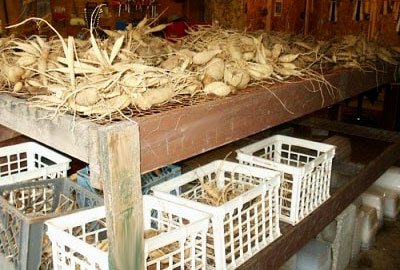

Now we will list the premises in which you can create conditions suitable for storing dahlias until spring. You can keep the rhizomes healthy:
- in the cellar;
- in the basement;
- in the pantry;
- in a refrigerator;
- on an unheated but glazed balcony.
Of course, in the absence of suitable storage facilities, tubers can be stored at home. But then by spring they will be shriveled and shriveled up. This will be poor quality planting material.
Processing dahlia tubers before storage in winter
To prevent diseases, treat washed dahlia tubers with a fungicide, for example, Fitosporin. Prepare the solution according to the instructions and soak the tubers in it for about an hour. Instead of fungicides, you can also use a pink solution of potassium permanganate. Soak the tubers in it for about 30 minutes.
Then label the tubers with the variety labels. If the variety is unknown, you can focus on the size of the bush, the shape or color of the flowers.
The next step in preparing dahlias for winter is drying the tubers. To do this, you need to choose a dark, cool place and put the bushes "upside down" so that the moisture accumulated in the stems flows out, and the tubers do not subsequently rot.
Plant preparation
In order for the dahlias to winter well, it is necessary to start preparing the plants in August. At the end of summer, the flowers stop feeding and watering is reduced. At the same time - from the end of August to the beginning of September - the plants are spud up to a height of 8-12 cm. This is necessary in order for them to be more comfortable with the autumn bad weather with its strong winds, which, in turn, leads to the formation of more robust and infection-resistant tubers.
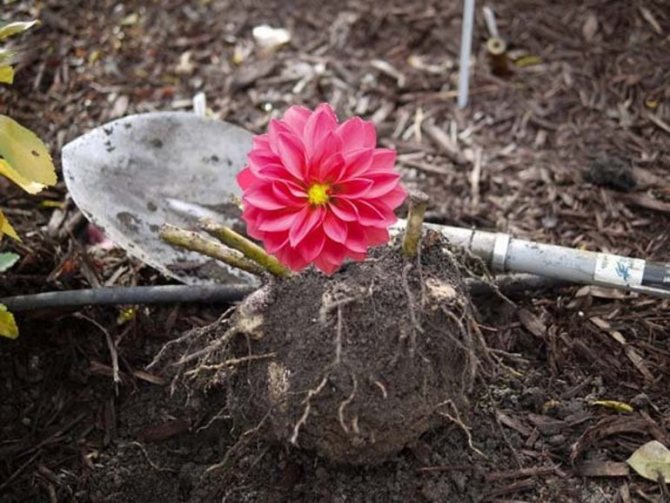

It is recommended to dig up dahlias in mid - late October, after they endured several night frosts. At this time, the trunks of the plants will already turn black, and the tubers will become hardened and subsequently will better tolerate storage conditions.
In order not to damage the underground part of the dahlias, the bush must be carefully dug with a pitchfork and, with their help, pull the roots out of the ground. In no case should the plant be pulled out, so as not to damage the base of the trunk. After the bush is removed from the soil, you need to cut off the stems with a pruner at a height of 10-15 cm from the tubers. Leaving "hemp" shorter is undesirable because of the possibility of penetration to the roots of the infection.
Advice!
If the weather is sunny, then it is best to leave the dug out bushes on the site for several hours, after which the soil adhering to the tubers is easily shaken off, and the roots themselves are carefully examined. All weak nodules and long roots must be carefully cut off, and the remaining underground parts must be washed thoroughly.
Clean tubers must be held for an hour in a fungicide solution or 30 minutes in a pink solution of potassium permanganate. This will help to destroy microflora dangerous for the plant. All sections must be treated with a solution of iodine or brilliant green.
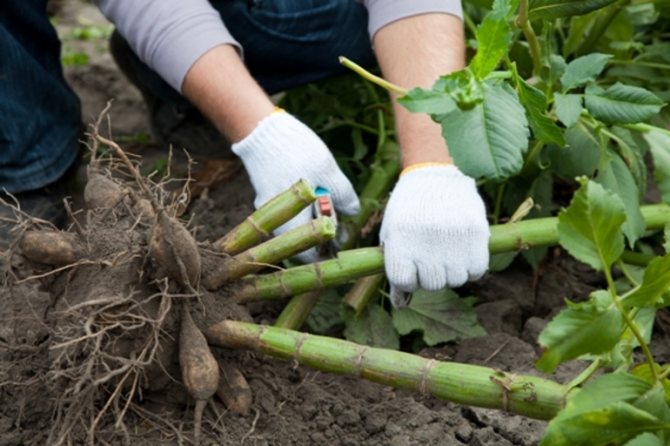

If the tubers begin to rot, it is advisable to discard them. If these are very valuable varieties of plants, then the sore spots should be removed with a clean knife, and the sections should be sprinkled with ash or smeared with iodine (brilliant green). It is necessary to store such plants separately from healthy counterparts.
Helpful!
To make it easier to recognize dahlias in the spring, a tag with the name of the variety or color is put on each "stump". After that, the tubers must be dried in a dark, cool place, for example, under a canopy or in the attic, for 2-4 days, placing them on "hemp" for better moisture removal.
It is not recommended to divide large rhizomes of plants before storage, this is an additional stress factor for them. It is best to postpone this procedure until spring, allowing the flowers to winter calmly.
How to store dahlias in the winter at home
Dried dahlia tubers are tightly placed in plastic buckets or boxes and covered with dry sand or sawdust, leaving the tops of the stems with tags not sprinkled. To prevent sand from spilling out of the box, you can lay a bag of sugar on the bottom, and then lay out a layer of newspaper.
Gardeners differ slightly on how to preserve dahlia tubers: some use wet sand instead of dry sand. Everything here is individual, and if the tubers were dug up in dry weather, and then not soaked in a fungicide solution, then it is really better to moisten the sand or sawdust.
There are several more ways to store dahlia tubers in winter:
- dip the tubers in paraffin melted in a water bath, put them in boxes and store at a temperature of 12-14 ° C;
- spread the tubers in a box on a layer of peat, sprinkle them on top and store at a temperature of 3-5 ° C;
- fold the tubers into a cardboard box by transferring them with paper or wrapping them in cellophane bags.
Storage of waxed dahlia
Place the waxed dahlia tubers in a cardboard box (for example, from under your shoes). Place the box in the coolest, driest place in your apartment (not in the refrigerator!). Storing in a cool place will give the waxed tubers a dormant period. In the warmth, dahlias can start growing ahead of time, which will weaken the plants.
At the end of February, I place the successfully preserved dahlia tuber roots in a warm, bright place, germinate and cuttings.
Lyubov Fyodorovna Golubitskaya (St. Petersburg) www.golubitsky.
All about the dahlia
Online
How to keep dahlias until spring? Choosing a storage location
The optimum temperature for storing dahlias in winter is 3-6 ° C, humidity is 60-70%. At lower temperatures, the tubers will freeze, at high temperatures, they will begin to germinate. There are several places where plants will be comfortable until spring.
Cellars and cellars. They are characterized by high humidity and low temperatures. The tubers will not suffer from drying out and will not germinate ahead of time. This is the best place to store dahlias!
Underground. The humidity here is lower than in the basement, and the temperature can be slightly higher, and air stagnation often occurs. Therefore it is recommended to turn on the fan in the room several times a week.
Refrigerator. Suitable place for a small number of dahlias. Place the tubers in a perforated bag and cover with sawdust. Check regularly for rotting. Suitable for storage are the lower or middle shelf, as well as the vegetable compartment.
Glazed balcony. Pick the darkest spot and place a box of tubers in it. If the temperature starts to drop, cover the drawer with old blankets or clothing. In frost, it is better to transfer the tubers to the room for a while.
Check the tubers periodically for signs of decay.
Protect the dahlias to prevent the tubers from being eaten by rodents. It is better to use fast-acting poisonous baits or ultrasonic repellents. There is evidence that mice and rats are intolerant of peppermint essential oil. To repel, soak paper napkins with oil, place them in glass jars without lids and place them in different corners of the room or near boxes of tubers. Change your wipes to new ones once a week.
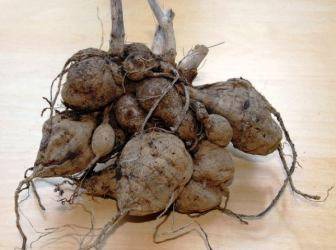

In household plots, dahlias have become one of the most common and favorite plants. Their inflorescences are very beautiful and varied in color, shape, size and doubleness. Dahlias are propagated by dividing root tubers' nests, cuttings and seeds. Dahlias grow well and bloom when the bush has one or two stems. Multistem shrubs give a small amount of flowers and form weak root tubers that are not easy to store. Therefore, the tubers must be divided.
Dahlias bloom until frost. In autumn, after the first frost, the aboveground part of the plants dies. After that, the stems are cut at a height of 10-15 cm from the ground, keeping the root collar. Then the root tubers are carefully dug out, washed from the ground, and thin roots are cut with scissors. After that, the tubers are dried and stored. In winter, they must be periodically reviewed, removing rotten and sick ones.
Preparing dahlias for storage is a very crucial moment. Some gardeners advise digging dahlia tubers after the first freeze, while others - after one or two weeks (by this time the tubers have time to ripen).
Successful storage of tubers at home depends primarily on how and when these tubers are harvested, and then how they are processed and stored. It is best, in his opinion, to dig up tubers in early October, when night temperatures drop to 0 -3 ° C, in dry, sunny weather. Dig it out carefully. First, you should free the upper part from the ground (open it), cut off the stem with a sharp knife, leaving a stump 15-20 cm high.Then dig a trench around the bush within a radius of 20-25 cm from the stem and carefully, with a shovel, remove the root tubers without touching the stem. If you pull on the stem, the tubers will come off, because they are very fragile and weakly attached to the root collar. After that, they are cleaned of the earth, small roots are cut off and the remnants of the earth are washed with water. Then the tubers, for disinfection, need to be dipped in a pink solution of potassium permanganate for 30 minutes and put them to dry for 20 minutes. After that, they are stored in a box on the balcony or in the garage, where the temperature is + 6-8 ° C and the air humidity is 60 -80%, In winter, you can store tubers near the balcony door.
Protection of tubers from pests
If you store dahlias with the paraffin method, then you will not be afraid of pests. However, in other cases, you may want to enjoy tasty and juicy tubers:
- thrips;
- barn ticks;
- rodents (mice, rats).
Visit the store from time to time to check the condition of the flowers. If you notice signs of damage to tubers with thrips or ticks, then treat them with any insecticide (Inta-vir, Aktara, Aktellik). But be sure to use a respirator and gloves, as working with poisons in an enclosed space is very dangerous. And in any case, do not process the rhizomes in the place where food is stored.
Poisoned baits, traps or special glue will help to cope with mice and rats. Currently, there are ultrasonic rodent repellents, but many gardeners have had time to doubt their effectiveness.
To be able to plant dahlias next year, they need to be saved until spring.But it is not enough just to remove them from the ground and place them in a basement or cellar. They need to be prepared: proper preparation of flower tubers for winter storage will help maintain the quality of planting material until spring.
Work order
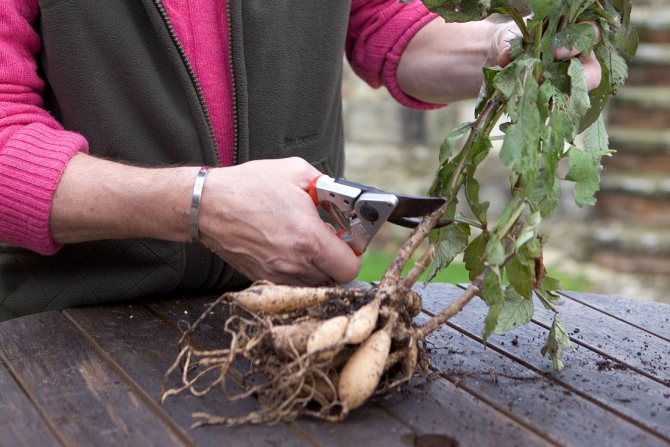

In order for the storage of dahlia tubers to go well, the first step is to follow the rules while digging them out of the ground. It is better to perform this manipulation with a pitchfork, since the shovel can damage the rhizomes. In this case, you must maintain a distance and do not stick the pitchfork directly under the plant stem. In addition to the above, you will need a pruner. The process of extracting root tubers from the ground is as follows:
- The bush is cut with a pruner at a distance of 10-20 cm from the ground, the inflorescences and frozen areas are sent to the compost pit.
- Dahlia rhizomes are dug up with a pitchfork, at a distance of 15-20 cm from the stem, they begin to raise the soil and select the tubers.
- Root tubers are carefully cleaned of soil and a label with information about the plant is attached to each specimen.
- After cleansing the rhizomes from the ground (it is impossible to wash with water), they are dried for 3-5 days.
- The damaged parts of the tubers, which became noticeable during drying, are removed, and the cut sites are treated with crushed activated carbon.
- After drying, it is permissible to shorten the remaining shoots to 5-8 cm. This reduction in the length of the shoots will facilitate the distribution of the rhizomes, especially this space saving is important in case of storage in an apartment in winter.
Attention! It is permissible to divide the old and large tuber into several, but separate only those parts that easily depart from the main one.
Useful Tips
In order for dahlias to delight their owners in the next planting period, experienced gardeners give several important tips:
- Dahlia tubers are best purchased from modern specialty stores. Such plants are less susceptible to harmful bacteria.
- Compliance with the temperature regime is the most important point in the storage of bulbs. If the temperature drops below freezing, the tubers will simply freeze.
- After wintering, the roots of the dahlias need to be divided. Otherwise, they may not ascend.
- If you plan to grow a large plant, it must be additionally fed from the moment it is planted in the ground.
Dividing tubers
Before "plunging" into the process of dividing tubers, you need to tell why this needs to be done:
- This is the easiest and most effective way to breed dahlias.
- Thus, the plant can be rejuvenated or prevented from aging.
As it turned out, dividing the tubers is not a necessary, but very useful procedure for the plant.
When is the best time to do it? Florists recommend carrying out this action in the fall, immediately after digging the tubers, before storing them. It can also be done in the spring before planting.
It is still better to divide in the fall, before the tubers have hardened:
- The first thing to do is trim the stems of the flowers. This is done so that a person can see the eyes.
- Next, you need to sterilize the working tool. It can be a pruner, scissors or a garden knife. This should be done before processing each variety of dahlias to prevent infestation. To do this, it is enough to hold the instrument over a fire flame for a few seconds.
- You should take a stump and divide it into two parts. It is worth considering that kidneys remain on each side of it.
- Each half must be stretched and divided into two parts again. Thus, four new tubers have already turned out.
- A similar procedure is required for each stump.
- Watch carefully for a bud at the top of each new tuber. If it is not there, then the dahlia may not germinate.
- When all plants are separated, it is required to check the appearance of each of them for the presence of diseases. If the color of rust is observed, then it is best to discard such tubers, they will die by spring.Holes of any kind from being eaten by insects are not dangerous for the future dahlia. It is also recommended to check the bottom of the tuber.
- The final procedure is repeated washing of the tuber to completely remove the contamination. It is recommended to additionally treat each division with sulfur or fungicide. In any of these two solutions, the tuber should be kept for no more than 15 minutes. After which they must be thoroughly dried on a newspaper.
When dividing dahlias, special attention should be paid to large tubers. It is best to leave them in storage in this form, as they will give fruitful roots, from which hardy bushes are obtained. ... Many growers still prefer to do this procedure in the spring for two reasons:
Many growers still prefer to do this procedure in the spring for two reasons:
- This is the most free period from horticultural affairs. You can set aside several days for thorough processing of the tubers. In the fall, due to the large employment of the harvest, not everyone can afford it.
- The buds on the tubers become ripe, it is several times easier to see them than when processing in the autumn.
Everything that remains after successful digging and dividing the plant needs to be prepared for storage.
It is not advisable to store dahlias after digging
Dahlia is a very finicky flower, and often beginner gardeners make a lot of mistakes.
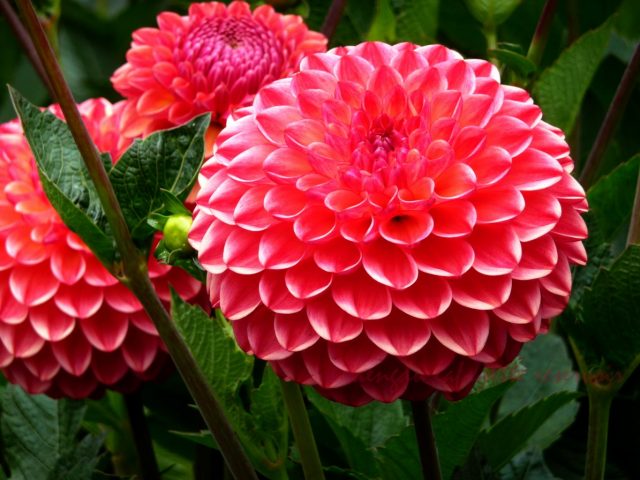

Dahlia is a beautiful flower that will decorate any area
Let's see what a violation of the rules can lead to:
- the stems may darken (occurs at a temperature of 0 degrees);
- buds, leaves and stems may die if the temperature is below 6 degrees;
- the bulb of the inflorescence will be damaged.
This happens if the storage rules are not followed correctly.
Here are some recommendations on how to store dahlias:
- don't miss the period when their flowers need to be harvested from the ground. They will remind themselves that they can no longer remain in the cold ground (the view will become much worse). Most often this happens after the first frost;
- after removing the plants from the ground, hang tags with the name of the varieties on them;
- it is forbidden to plant dahlias as they were dug up. They should be separated;
- carefully observe the temperature regime. Avoid cooling or, conversely, too high a temperature;
- purchase an indoor humidifier.
At what period should dahlia tubers be dug?
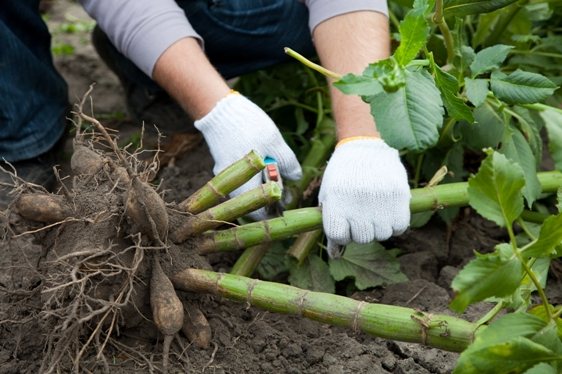

If your plant feels quite well, and the greens have not lost their attractiveness, and the flowers continue to delight with bright colors, it is worth waiting for some more time, since it is during this period that buds are laid for the next year, and the root system intensively accumulates nutrients. Interrupting these important processes means not allowing the plant to form properly for future flowering.
In the event that the tubers are ready to be dug out, do this with extreme caution so as not to damage the buds and young tubers that have grown this season. They are very brittle, and as soon as they are touched with a shovel, they break off. In order to avoid this, do not dig close to the roots or pull on the stem, it is best to dig carefully around the flower and carefully pull out the tubers with your hands. The success of winter storage will depend on how correctly you do this.
Indoor storage
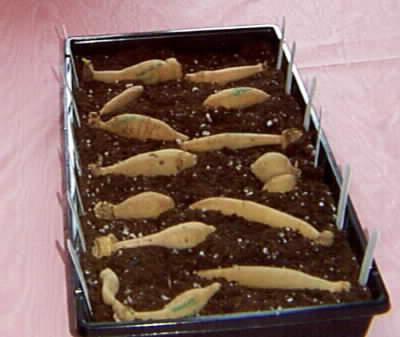

Despite the fact that a dry and clean basement would be the best place for storing dahlias, flowers are also well stored in room conditions, but for this it is necessary to fulfill a number of conditions:
It must be remembered that at high air temperatures, the roots can release shoots, germinate, but due to lack of nutrition or moisture they can die.
Several well-known home storage methods
Florists don't go to any lengths to preserve their favorite flowers; various materials are used for this: sawdust, vermiculite, paraffin, sand.Everyone invents their own way of storing dahlias for the winter.
If you have a dry basement or an unheated dark room, crates are the best place for tubers. Peat is laid at the bottom of the box and the signed tubers are already laid out on it. From above, they are also covered with peat. Alternatively, you can use dry sawdust or river sand in the same way.
In the case of sand, the following should be done: pour sand into the box, lay the roots, you can put it in several layers, and put burlap on top. This method has found many fans and is used very often. It is worth removing the bag and all the roots as "in the palm of your hand", you can check their condition and throw away the damaged ones.
It's important to know! It is better to dry out the dahlia tubers than to give them excess moisture, so the sand can be used if the room is really dry.
Sawdust or large wood chips are also a good option for storage, small sawdust should not be taken, as they instantly absorb moisture, and this provokes shoot germination or rot. If you nevertheless decide to place the roots with sawdust packages, in no case close them tightly, concentrate will accumulate inside and the planting material will quickly deteriorate.
Coarse vermiculite is also a material suitable for storage, it does not allow the nodules to dry out, and at the same time it retains moisture necessary for life in the root structure. They are sprinkled with vermiculite and placed in boxes or other containers. The temperature regime in the room where storage is carried out should not exceed six degrees.
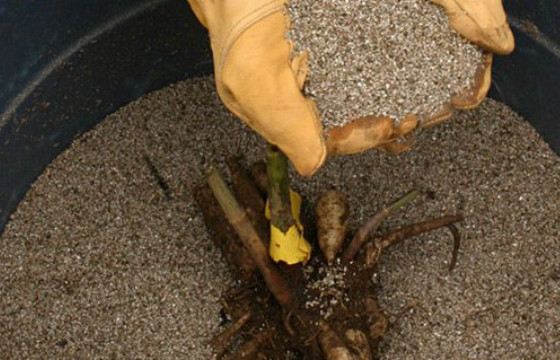

It is very important to remember that tubers do not store well next to other vegetables, such as potatoes or carrots. Such a neighborhood is fraught with a humid environment and the spread of fungal infections.
Features and storage rules
Before you get acquainted with the rules for storing dahlias, you need to figure out what can happen if they are violated:
- Darkening of the stems. Often occurs in late autumn, when the air temperature approaches 0.
- Death of buds, leaves and stems. This happens if the temperature drops to -6 degrees.
- Damage to the inflorescence bulb.
To prevent this from happening, it is important to observe the correct storage conditions for the dahlia.
Division of roots
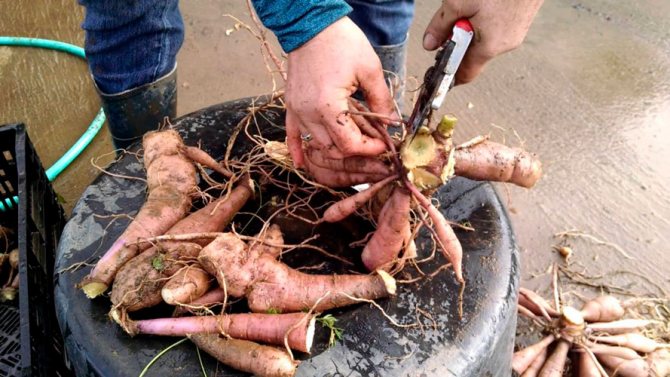

Divide tubers
The division of the roots is carried out in such a way that an intact bud remains on each separated piece of the root, which will give a new shoot in the spring.
Expert opinion
Mikheeva Tamara Gennadievna
Dedicates most of his time to flower beds in his garden and landscaping
Ask a Question
It is better to divide the roots into parts with a sterilized tool in order to protect the tubers from spreading viruses from diseased roots to healthy ones. To do this, just hold the blade over the fire. However, remember to cool down the instrument immediately afterwards to avoid scalding the next tuber.
Some gardeners believe that large dahlia tubers should be thrown away as they form very few suction roots, which causes a significant decrease in the quality of the tubers. Hence, there is an opinion that small representatives of planting material for dahlias produce better and more hardy plants.
After dividing, it is recommended to water the trimmed roots again with water to wash off the remaining dirt from the root.
Only healthy root tubers are taken for storage, so they are carefully examined. If you see dark brown or rusty-yellow spots on the roots, white bloom, then it is better to remove them so that diseased roots do not spoil the rest of the planting material.
Care during storage
During winter storage, the condition of the root tubers should be periodically checked. At the same time, those specimens are removed that look sick, have begun to rot or have become moldy. If the air in the room is excessively dry, then sometimes the material in which the dahlias were left is slightly moistened.Such care is provided to rhizomes until spring, when the risks of recurrent frosts have already disappeared.
Why and how to mark the roots
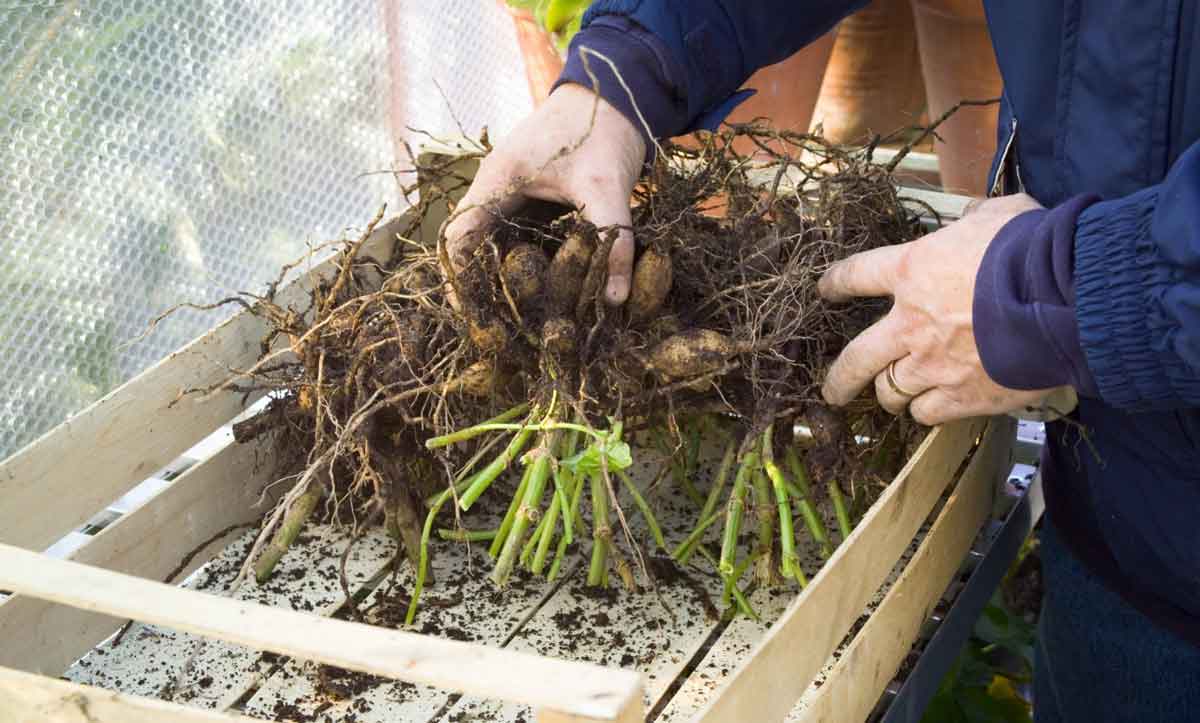

Dahlias are labeled so as not to forget where which variety lies, when it was sent for storage and what features it has. For marking, tags made of paper or thin plastic are used. A thin cord is threaded through them and tied to a tuber. Information is written on the tag to prevent re-sorting. Also, the "strongest" specimens are additionally marked with some kind of symbol - in order to know that they can be used for cuttings in the new season.
On a note! Marking tubers is especially important in cases where there are many varieties and plan to plant them in a certain order, creating a floral arrangement.
Tips on where to store dahlias in winter
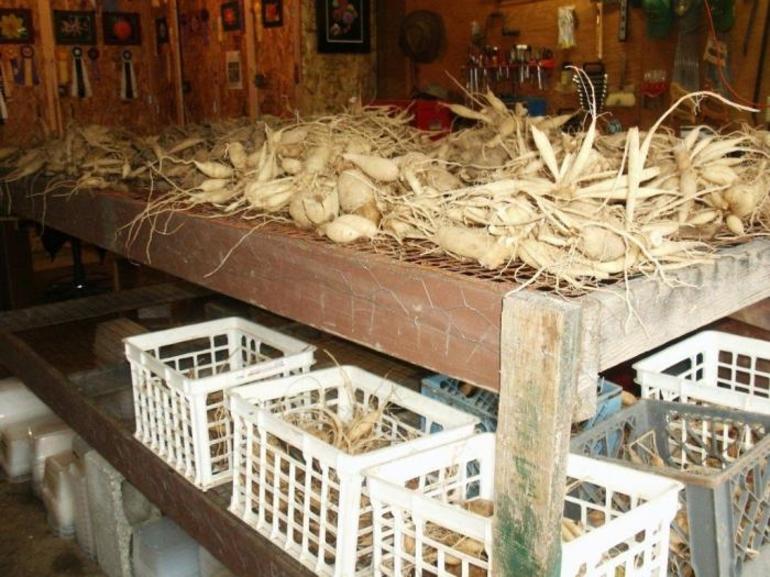

Dahlias in the winter season can be stored both in the apartment and in the basement. The main thing is to provide them with a suitable microclimate. To correct the high humidity in the basement, the rhizomes are sprinkled with moisture-absorbing materials. If they are kept in them in an apartment, they choose a place where the illumination is low, you can keep dahlias in a pantry or other suitable cool place. The main thing is that the humidity and temperature are within the recommended values.
It is also permissible to keep tubers in an apartment on a glazed balcony or a warm loggia, and not only in a refrigerator or pantry. But, it is necessary to insulate them well - so that sub-zero temperatures do not affect them. To do this, they are folded into a special thermal box or, during periods of severe frost, they are covered with unnecessary warm things, a blanket. It is permissible to bring it into the apartment if the temperature even on the insulated balcony has become subzero.
Follow-up actions until storage
Those gardeners who grow many different varieties of dahlias can easily get confused, since tubers of all colors, like twin brothers, are very similar to each other. In order to know where which variety will be stored, the tubers are usually marked. This can be done in various ways:
- The first way is to number each tuber, and then add the number and name of the variety to the list.
- The second option is this - picking a flower during flowering, and after drying it, the growers tie it to the tuber and already know exactly what color, variety and variety it is.
- The third way is the most convenient - to write the name of the variety directly on the tuber, then you certainly won't get confused.
All these measures are needed for those who are fond of dahlias and have several dozen varieties and types of plants. Marking allows you to control the storage and planting flowers in the spring with an understanding of how tall, voluminous and spreading they are.
An interesting way
Now I will tell you about the most ideal way to store dahlia tubers. There is never any loss here, and the planting material in the spring looks like it was brought from a flower garden yesterday. I warn you right away - if you live in an apartment, then this method is not for you.
You will need a large plastic barrel, a wooden box, and some plastic. Place the roots wrapped in a soft cloth or thick paper in the barrel, close the lid. Pre-punch a few holes in the cover with a drill.
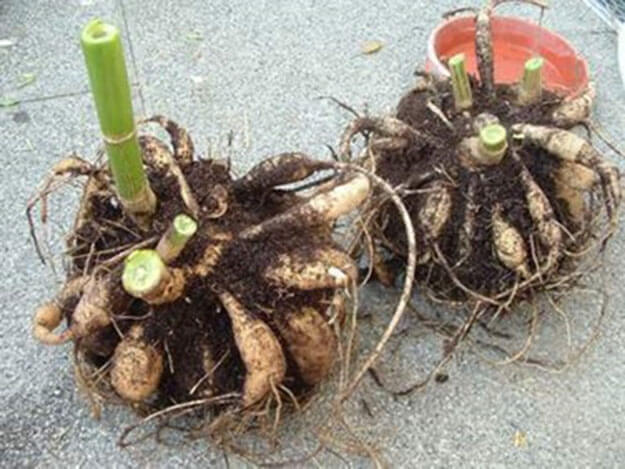

We proceed to the most difficult process - preparing the pit. Please be patient, because the barrel needs to be buried completely! Lower it into the pit, set the box on top - the contents of the container should breathe. From above, carefully cover your structure with polyethylene and cover it with a thick layer of soil. In winter, try to get more snow on the buried barrel, and if the winter is snowless and frosty, you can put some spruce branches or dry leaves.
What to do after digging
Here are the tubers dug out, cleaned of soil residues. Now the disinfection procedure follows, it is necessary to disinfect the roots from diseases and pests that may have already penetrated into the juicy nodules.Prepare a weak solution of potassium permanganate in a basin or other container and place the tubers of the plant there.
The time interval for such an important process should be at least half an hour. You can replace potassium permanganate with any other store-bought insecticide
Then you should study the instructions before processing dahlias and follow the manufacturer's recommendations. With this approach, you will keep the flower tubers healthy and strong until the next season, because disinfection destroys pathogenic bacteria, which means that the decay processes will be reduced to nothing
Pay attention to the nodules that float up, they are already unsuitable for further use, so they can be safely thrown away.
Processing should be done with gloves in order to avoid provocation from chemicals.
Rules for digging tubers for storage
Dahlias cannot be dug out just like that, they must ripen. The longer they stay in the earth, the better. And the signal to start cleaning is the first serious frost.
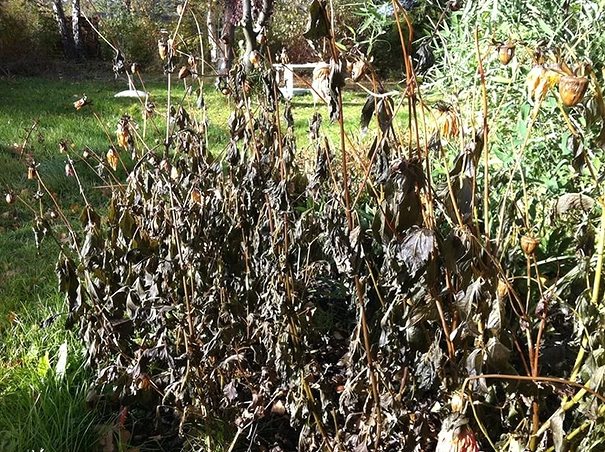

After it, it is no longer possible to postpone. Frost-affected leaves and stems will begin to rot intensively, and it is likely that the rot will spread to the tubers. If, after freezing, a rather long warm weather sets in, the growth buds at the root collar can wake up and start growing again, which is completely unnecessary.
Important! In order not to wake up dormant growth buds, dahlias are not cut until the first frost.
Before harvesting, all dahlias are cut off, leaving only a stem 0.3–0.4 m long. Despite the fact that the tubers of dahlias are shallow, they cannot be pulled out by the stem. It is necessary to gently pry the bush with a shovel or a pitchfork from below and turn it out to the surface of the ground. After that, the tubers need to be shaken off the ground, trying not to grab the root collar.
Using a knife or secateurs, root tubers are cleaned of roots, small nodules, and rotten processes. Only fully formed tubers should be left attached to the root collar. After cleaning, you should completely cut off all the remains of the trunk and divide the rhizomes, making sure that there are formed buds on each tuber. Solid tubers may not be split if the buds are underdeveloped.
In wet weather, a lot of sticky dirt remains on the tubers. It can be washed off with water, and then the rhizomes can be dried by laying them tubers up under a canopy, on the veranda or in the attic of the house.
Important! Before laying the tubers for storage, it is advisable to spray them with a solution of potassium permanganate, and it is better to dilute it in a bucket until red and hold the tubers there for half an hour. This will disinfect them.
You can also use a fungicide solution for this.
Dahlia root. Dahlia
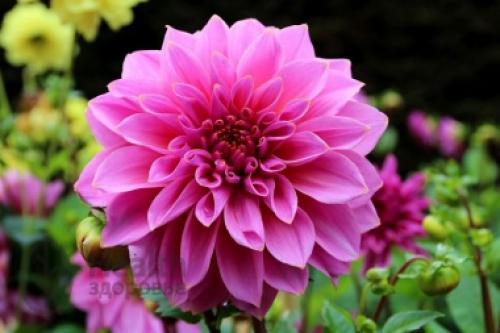

Sin .: dahlia.
Dahlia is a genus of flowering annuals or perennials. Representatives of this genus are used as ornamental plants, with their help they decorate gardens, vegetable gardens, front gardens. In Mexico, some parts of the dahlia are used for food, the petals are added to salads, and various drinks are prepared based on the tubers. Officially, the plant is not used for medicinal purposes, but in folk medicine it is used as an anti-inflammatory, antifungal and immunostimulating agent.
In medicine
Dahlia is not included in the State Pharmacopoeia of the Russian Federation and is not used in official medicine in Russia. However, Mexican healers have found use for this plant and use it as an anti-inflammatory, antifungal and immunostimulating agent.
Contraindications and side effects
Since representatives of this genus are not used in official medicine, it is difficult to judge the presence of contraindications and side effects. Any use of dahlia for medicinal purposes is contraindicated!
In gardening
To successfully grow these unpretentious ornamental plants, it is very important to choose a good planting site. First of all, you need to avoid drafts and an excess of direct sunlight.Experienced gardeners recommend planting dahlias near trees so that the plants are periodically in the shade.
Watering is recommended once a week; during heavy rains, watering is not required. Weeding and irrigation of the land is carried out at least once every two weeks. For abundant flowering, the plant is fed with organic fertilizers.
At the first frost, the aboveground part of the plant is cut off, the tubers are dug out of the ground, dried in a warm room during the day, then stored in a cardboard box with sand at an air temperature of 18-20 degrees.
Today, there are about 15,000 different species and their forms. In most cases, hybrid varieties of dahlias are cultivated. In biology, it is customary to subdivide dahlias into several groups:
· Collar. The petals are arranged in two rows, each row has its own color. The maximum is able to reach 50 cm in height. Varieties: heart of Danko, Malivista and others.
· Peony. Outwardly they look like peonies. They have two rows of petals. The middle is golden. Varieties: Eternal Flame, Danko and others.
· Pompom. Outwardly, they resemble a slightly flattened ball. They are classified as medium-sized, up to 1.5 meters in height. Varieties: Kid, Crombie and others.
· Spherical. The name speaks for itself, terry inflorescences, resemble a ball. In length, the plant can reach one and a half meters. Varieties: Cambri, Evelyn and others.
· Semi-cactus. The petals closer to the middle are twisted into a tube. Varieties: Cherry, Vicky, Meteori and others.
· Cactus. A distinctive feature is the structure of the petal. They are twisted into a narrow tube and resemble a cactus. Tall, capable of reaching up to 2 meters in height. Varieties: Candy, Black Wizard and others.
· Nymphaean. They have terry large inflorescences, up to 20 centimeters in diameter. Varieties: Leo, Kens, Nabat and others.
· Mixed. This includes all other varieties that do not belong to the previous groups.
In cooking
In Mexico, dahlia is also used in cooking, mainly its petals are used, they are added to salads and various dishes. They add a certain zest to the food. Tubers are also used for food, drinks are made from them and consumed instead of the usual tea or coffee. To improve the taste, milk or cream is added to the drink. The edible parts of the dahlia have a low calorie content, the plant can be an excellent solution for organizing dietary meals. Note that in Russia, dahlias are exclusively ornamental plants and are not used for food.
In other areas
Low-growing varieties of dahlias are suitable for creating ridges, borders, arrays. Some species are used in free compositions and group plantings; in single plantings, abundant or large-flowered varieties are effective. Varieties with long and strong inflorescences are used for cutting.

